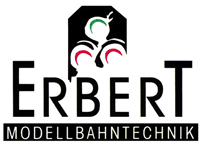![]() Take Control
Take Control
> main > modelling > control
To control your layout you now have several options. You can have conventional analogue control (furter referred to as DC or AC, depending on the manufacturer of your rolling stock and track), DCC (digital command control), other command control systems or direct-to-the loco radio or infra-red control systems. On this page I will explain a few control systems with links to manufacturers for further information.
Conventional DC or AC control
Using this kind of control has the advantage that it is to understand with basic knowledge of electricity and how electric circuits work. When you have a large layout the wiring can become very complicated and it is good to have good drawings of how the wiring is done. This is strongly recommended for all model railway wiring on any layout larger than a 4x8 ft board (1x2 metres). To control your trains you can either use the power pack supplied with the starter set or a more powerful power pack (transformer/controller). When using power packs I recommend a rating of at least 1 Amp, even for N-scale! European power packs offer single-knob control and an auxiliary 16V AC output for points and accessories. The manufacturers normally state for which system their equipment is made. Do NOT USE Märklin or other AC power packs, Japanese model trains all run on 0-12V DC.
![]() Japanese
model railway
control
Japanese
model railway
control
In Japan most manufacturers (Kato, Tomix,
Endo, KTM) offer
transistorised
analogue controllers, which offer a much smoother control than the
conventional
transformer-controllers
offered by European manufacturers. Apart from smoother control, Kato
and
Tomix
also have paid attention to the whole wiring system and both
manufacturers
have a convenient plug-in wiring system. However, the Kato and Tomix
wiring
systems are not compatible due to different plugs. Both Kato and Tomix
use an easy to use plaug-and-play cabling system. More information is
available through the
links
below.
![]() An introduction
to
the Tomix control system
An introduction
to
the Tomix control system
A short description of the controllers and switches offered by Tomix.
An introduction to Kato's controllers and Kato's digital command control system, one of the early systems that was not very successfull.
 Digital Command Control
Digital Command Control Some backgrounds on Digital Command Control, not only NMRA DCC.
Some backgrounds on Digital Command Control, not only NMRA DCC. A brief history of the development of NMRA DCC.
A brief history of the development of NMRA DCC. Overview
of DCC systems, an overview of the various systems available. Please
note that the list is not complete, some systems may not be compatible
with N-scale models or may not be available in the country you live.
Overview
of DCC systems, an overview of the various systems available. Please
note that the list is not complete, some systems may not be compatible
with N-scale models or may not be available in the country you live. Cab-style
controllers. Many modellers always wanted to be a
train
driver. Well with a cab-style controller you can
be
in the driver's seat of your own model train. I made a survey of
what's
available from both Japanese and European manufacturers, both analogue
and
digital (DCC).
Cab-style
controllers. Many modellers always wanted to be a
train
driver. Well with a cab-style controller you can
be
in the driver's seat of your own model train. I made a survey of
what's
available from both Japanese and European manufacturers, both analogue
and
digital (DCC).
 An overview of the methods and interfaces used to convert analogue loco models into DCC-controlled locos, the art of fitting a DCC-decoder.
An overview of the methods and interfaces used to convert analogue loco models into DCC-controlled locos, the art of fitting a DCC-decoder.
 Modern Smartphones could also be used to control your layout. Very promising and providing lots of fun!
Modern Smartphones could also be used to control your layout. Very promising and providing lots of fun!
 Your smartphone can now control analogue DC locos as well. A portrait of 4 app-controlled controllers.
Your smartphone can now control analogue DC locos as well. A portrait of 4 app-controlled controllers.
 Links to manufacturers of analogue model railway control equipment, both analogue and digital (DCC).
Links to manufacturers of analogue model railway control equipment, both analogue and digital (DCC).
These can be controlled with various switches and other controls. It is best to build a control panel where all switches are mounted in such a way that they can easily be identified and that their function is clear. You can build such a control panel yourself or use a 'domino' type system that is offered by several manufacturers. When using DCC it is possible to use your computer as a control panel using special software. This software can also control locomotives and even trigger sound and lighting effects etc.
As you can see, the SES control panel is made up of hexagonal sections. These sections clip together, the hexagonal shape is space-saving, so the resulting panel is still very compact, without impairing clarity. SES now offers control panels with LED or incandescent (bulbs) indicator lights. Special colour combinations are available on special order..SES offers an interface to connect SES control panels to XpressNet (Lenz DCC control bus).
 MegaPoints Controllers offer a modular point and signal control system that makes use of I2C
nnd CAN bus technologies. Products have a learning curve, and can be
used on almost any layout, with analogue DC or DCC train control.
MegaPoints Controllers can also supply mimic panels and offer a panel
building service.
MegaPoints Controllers offer a modular point and signal control system that makes use of I2C
nnd CAN bus technologies. Products have a learning curve, and can be
used on almost any layout, with analogue DC or DCC train control.
MegaPoints Controllers can also supply mimic panels and offer a panel
building service.
 Erbert
Modellbahntechnik offers miniature versions of the
control
panels that are used by the German railways. No surprise that these
work best
on German-prototype layouts, with the correct signals that are also
offered
by Erbert. Erbert also offers control panels that connect directly to LocoNet..
Erbert
Modellbahntechnik offers miniature versions of the
control
panels that are used by the German railways. No surprise that these
work best
on German-prototype layouts, with the correct signals that are also
offered
by Erbert. Erbert also offers control panels that connect directly to LocoNet..
 Min Wa Electronics
offer a huge range of step-down transformers, DC power supplies and
battery
chargers.
Min Wa Electronics
offer a huge range of step-down transformers, DC power supplies and
battery
chargers.
 For those with an interest in experimenting, building and programming control devices, the Arduino provides a nice platform. These have great potential for railway modellers!
For those with an interest in experimenting, building and programming control devices, the Arduino provides a nice platform. These have great potential for railway modellers!
Written by Mark Veneman
All company logos are registered trademarks
 Modelling
Modelling Layouts
Layouts Modeller's
Corner
Modeller's
Corner  Train Simulators
Train Simulators  Various
Various